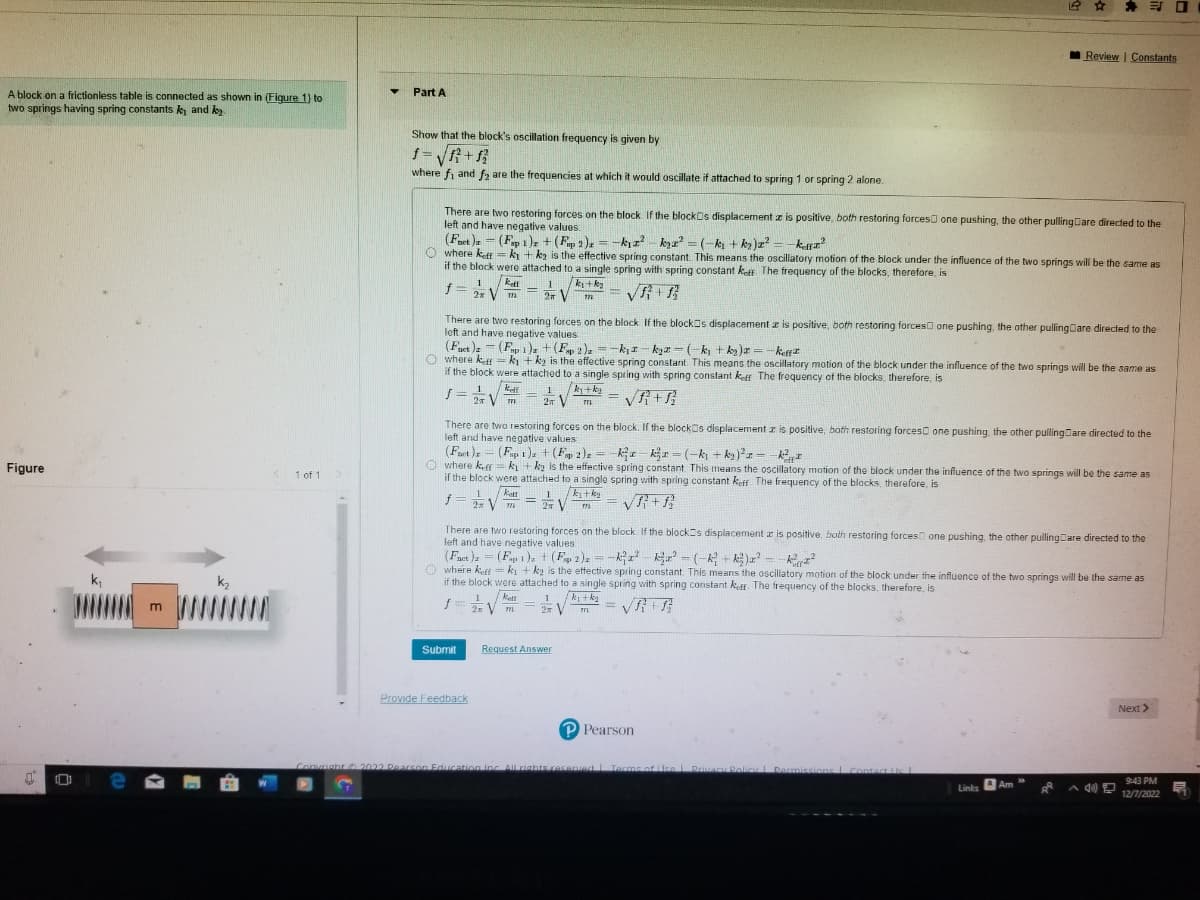A block on a frictionless table is connected as shown in (Figure 1) to two springs having spring constants ky and ky Figure m K₂ 1 of 1 Y Part A Show that the block's oscillation frequency is given by 1=√√√R+R where fi and f₂ are the frequencies at which it would oscillate if attached to spring 1 or spring 2 alone. There are two restoring forces on the block. If the blocks displacement az is positive, both restoring forces one pushing, the other pulling Care directed to the left and have negative values: (Foet) (Fap 1) + (F2)z-k₁z²kya² = (-k₂+k₂)² = k₁² Owhere kefky + ky is the effective spring constant. This means the oscillatory motion of the block under the influence of the two springs will be the same as if the block were attached to a single spring with spring constant keff The frequency of the blocks, therefore, is = √R R 1 kett f= f = 2x V m √ = 2T √ m - There are two restoring forces on the block If the blocks displacement z is positive, both restoring forces one pushing, the other pulling are directed to the left and have negative values i (Fuet) (Fup 1) + (Fp 2)a-ka-ka-(-k₁+k₂)α-k where kettky + ky is the effective spring constant. This means the oscillatory motion of the block under the influence of the two springs will be the same as if the block were attached to a single spring with spring constant kett The frequency of the blocks, therefore, is Keff 1 ky + ky 2 √R+1} m 1 2T V There are two restoring forces on the block. If the blocks displacement z is positive, both restoring forces one pushing, the other pulling are directed to the left and have negative values 1 katt f = √ = 27 776 (Fot) (Fup 1) + (F2) -kk-(-k₁+k₂)²-- where kefkyky is the effective spring constant. This means the oscillatory motion of the block under the influence of the two springs will be the same as if the block were attached to a single spring with spring constant keff. The frequency of the blocks, therefore, is 1k₁+k VR+B F 1 Kett 1= 2√ m k₁+k₂ 771 There are two restoring forces on the block. If the blocks displacement a is positive, both restoring forces one pushing, the other pullingCare directed to the left and have negative values. - (Fact) (F1) + (F₁2)x= -²²²²-(kk) ²² where katky + ky is the effective spring constant. This means the oscillatory motion of the block under the influence of the two springs will be the same as if the block were attached to a single spring with spring constant kett. The frequency of the blocks, therefore, is VRT 1 2m V = 172 Submit Request Answer k₁+k₂ 771 = +
Simple harmonic motion
Simple harmonic motion is a type of periodic motion in which an object undergoes oscillatory motion. The restoring force exerted by the object exhibiting SHM is proportional to the displacement from the equilibrium position. The force is directed towards the mean position. We see many examples of SHM around us, common ones are the motion of a pendulum, spring and vibration of strings in musical instruments, and so on.
Simple Pendulum
A simple pendulum comprises a heavy mass (called bob) attached to one end of the weightless and flexible string.
Oscillation
In Physics, oscillation means a repetitive motion that happens in a variation with respect to time. There is usually a central value, where the object would be at rest. Additionally, there are two or more positions between which the repetitive motion takes place. In mathematics, oscillations can also be described as vibrations. The most common examples of oscillation that is seen in daily lives include the alternating current (AC) or the motion of a moving pendulum.

Trending now
This is a popular solution!
Step by step
Solved in 2 steps with 1 images









